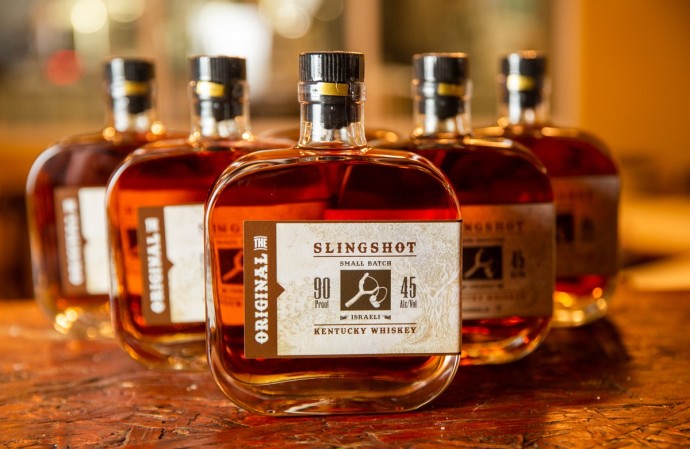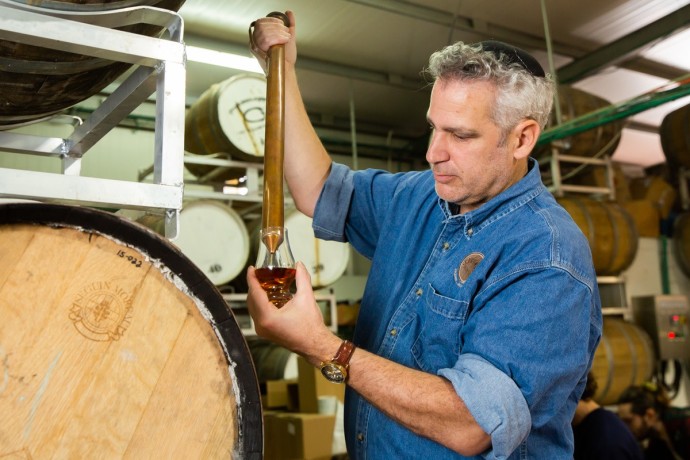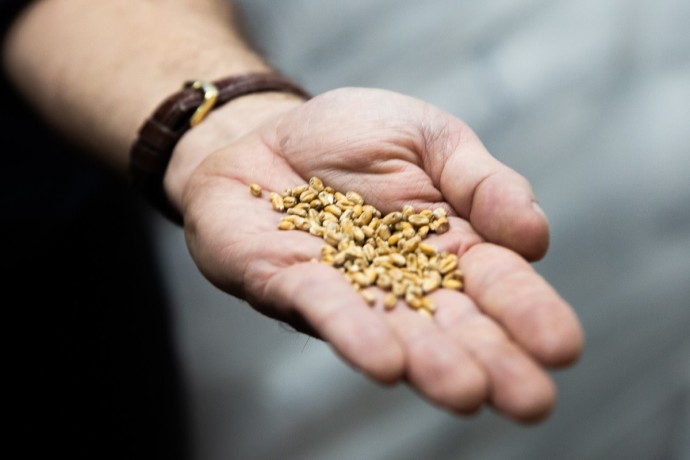In 550 B.C.E. in the Ella Valley a young King David killed the giant Goliath with nothing more than a slingshot and faith in God, according to the Book of Samuel. In 2022, two American immigrants developed a “Slingshot” of their own only a stone’s throw away from where that battle is believed to have occurred.
Meet Noam Cohen and Alan Cohl, the American immigrants who are making one of Israel’s only whiskeys on this ancient battleground.
“How are legends made?” the new Legends Distillery in Ella Valley asks on its website. “Steadfastness. Steel nerves. A smooth stone. A slingshot. Simple things indeed.
“But when David combined them one day 3,000 years ago, they spelled the end of the towering Goliath and the beginning of a legend that would dominate our national conscience for millennia.”
The company recently released Israel’s first American-style whiskey, Slingshot.
“Slingshot pays homage to probably one our greatest legends,” said Legends co-founder Cohen. “The biblical connection is what you make of it. We have products that are planned for the future that will be named for various other legends.”
Located along Route 375 – near its junction with Road 38 – Cohen said the whiskey is “the meshing of American tradition with a little Israeli innovation.”
“If you look at our logo and our label, there is a wagon wheel resting on an olive tree,” Cohen said. “The wagon wheel symbolizes American tradition: covered wagons going West. The olive tree symbolizes our return to this land after years of exile and making the land bloom again – the ancient Jewish land.”
Legends just completed its first bottling at the end of last year and hit shelves in Israel only three months ago. Today, the whiskey can be found in 50 stores, but the company expects to expand to a few hundred more soon, its director of marketing Doni Cohen said. The company is also in talks with a US distributor so that the whiskey can be sold abroad.
Prices range from NIS 235 to NIS 325 per bottle.
Moreover, Cohen said the ultimate goal is to become a tourist attraction, especially for Christian visitors who before the pandemic made up more than 50% of travelers to the country and who they hope would be interested in experiencing a classic American drink made in the heart of Israel.
“We hope to host many Christian tours here,” Cohen said, noting plans to build a visitors center, which would first involve paving the roads that lead to the distillery.
Legends is renting space from Mosco Beer in Moshav Zano’ah. The Book of Nehemiah tells of the re-establishment of Zano’ah after the return of the Jews to Zion.
“This is a key area,” Cohen said, noting that the Bible refers to the Ella Valley as a place of vineyards and wine.
“Our whiskey is the next stage,” he said.
The birth of bourbon
The idea for Legends came about during a late night gathering between Cohen, Cohl and some of their other friends in their Judean Hills community of Efrat.
“We would get together every couple of weeks in the evening and smoke and drink and solve the world’s problems,” Cohen recalled with a laugh. “One night, after everyone went home, Alan and I were sitting together, and we looked up at the stars – it was like 1 a.m. – and we were smoking and discussing the nuances of the flavor of the bourbon we are drinking, and then we looked at each other and said, ‘Why the hell are we not doing this?’”
One thing led to another, including various trips to the United States to train, research and analyze. Five years later, Legends was born.
“The idea with Legends is not necessarily to reinvent the wheel, but to take what people have been doing for the last few hundred years and just do it better,” Cohen said.
“Our beginnings are very humble. We are basically in someone’s backyard over here,” Cohen continued, looking around the outside of the distillery, where small houses line narrow roads. “This is very appropriate. Bourbon’s birthplace was in surroundings just like this.”
Cohl is eager to share the history of the drink, which he said began in the late 1700s to early 1800s when people were pushing West in the United States. They planted grains to eat, but when they had leftovers, it would rot or get infested. So, they started turning it into alcohol.
As they pushed further West, past the Appalachian Mountains, they found “unbelievable rolling terrain: Kentucky,” Cohl said. This area was more suitable for growing corn. But like on their earlier farms, they had nothing to do with the excess corn, so they made it into bourbon.
“Bourbon is an immigrant product,” Cohl said. “Most of the settlers that were in that part of Kentucky paid homage to the French who helped them in the Revolutionary War. When the first product was marketed it was called Bourbon County whiskey, not just bourbon.”
He said the folks that lived in that county were Irish, Germans and Scotts.
“They came to the land, they found the opportunity to grow corn as the most abundant grain and just did what they knew from back home,” Cohl said. “In one way, we are bringing the same tradition here – bringing our American tradition, our own baggage, to a different place.”
Bourbon vs. whiskey
To be clear, Legend’s is making Kentucky-style whiskey only because by US law, bourbon is only bourbon if it is made in the USA. Whiskey is the umbrella name referring to grain-based alcohol. Bourbon is whiskey made primarily of corn.
The rule is that bourbon must be at least 51% corn, Cohen explained. Legends’ Kentucky-style whiskey is 60% corn, 30% wheat and 10% barley.
“Corn is the sweetest of grains, but it comes with a certain harshness,” he said. “What we did was add a large amount of wheat to the recipe. Wheat is mellow grain, even creamy, and serves to mellow out the flavor so it can enjoy the sweetness of the corn without the harshness.”
The company currently imports its grains but said it hopes to grow its own corn in the coming years. It is in negotiations with several area kibbutzim.
“There is nothing more beautiful than a corn field,” Cohen said.
The whiskey is matured in casks made of American oak, which Cohl said is key to the whiskey’s flavor. They char the wood inside the barrels to give the whiskey a bit of a smokey flavor.
The founders expected that the whiskey would need to age for three years in its barrels but were pleasantly surprised when they found that in Israel, partially due to the unique climate in the Ella Valley, the aging process takes half the time - “it literally happens doubly as fast in Israel,” Cohl said.
“A lot of Israelis come over and they say. ‘I am not a bourbon person,’” Cohen said, noting that he hopes to change that. “We love bourbon. It runs through our veins.”
Cohen and Cohl used their personal equity and additional private investors to get the company started and maintain their day jobs as a finance professional and architect, respectively. But they said they hope to make Legends a full time job in the next couple of years.
What’s after Slingshot?
The Ella Valley is also where the biblical hero Samson was born and worked.
“I don’t want to give too much away,” Cohl said, “but the next legend we’re talking about is Shimshon HaGibor.”



